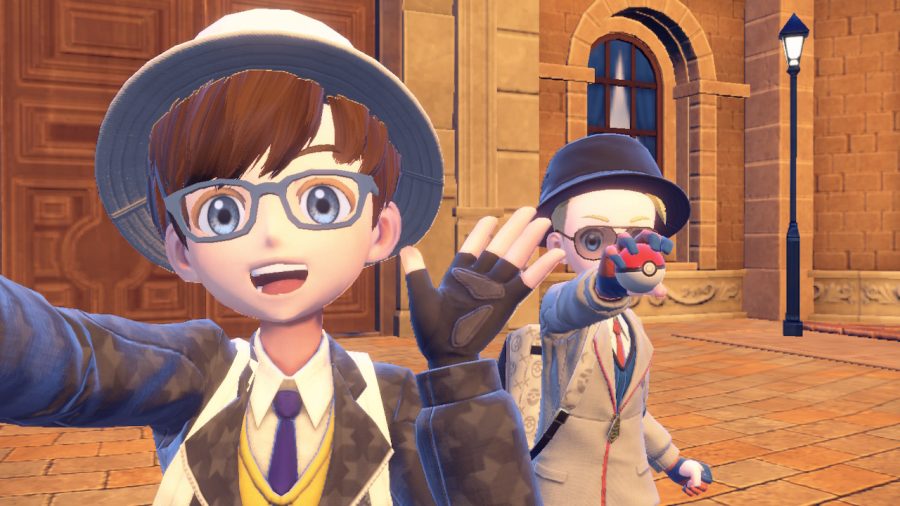Stevens: Pokémon Scarlet, Violet are roller coasters of varying quality
Shown are Levi Stevens and his friend playing as virtual characters in Pokémon Violet.
February 11, 2023
The Pokémon franchise has developed a controversial track record in the past few years.
As the video game series jumped from handheld systems to consoles, the games needed some time to find their footing. After the release of Pokémon Sword and Pokémon Shield, which were somewhat formulaic and lacking in content, the series was stagnating. The developing studio, Game Freak, defied expectations two years later with the release of Pokémon Legends: Arceus. This game broke free from the typical linear route of Pokémon games by giving players free reign to explore an open area while catching and battling Pokémon in a dynamic world.
Although Arceus wasn’t free from some graphical and technical issues, things were looking bright for the series earlier this year. However, the announcement of the next big Pokémon game a mere month after its release was concerning, to say the least.
Was this quick announcement a sign the upcoming games would be rushed for their typical yearly release once again? Unfortunately, I’d say yes. That, however, doesn’t mean the game doesn’t have merit.
For this review, I played through Pokémon Violet. For those who aren’t aware, Pokémon games are typically released in sets of two. This dual-release strategy allows players to catch exclusive Pokémon to trade with the other version of the game. Other than some minor changes, the game remains the same.
The biggest talking points for these new games are the immense performance issues. While I typically don’t seek the most optimal graphics in video games, the visual glitches and poor textures were even noticeable to me. Entire mountains will often melt into globs of pixels, while the shadows from nearby trees will flash sporadically. This game isn’t pretty, and it doesn’t have much room to be. Even without these performance issues, the landscapes often feel like drab, empty lumps of grass and snow with Pokémon that happen to be there.
These visual issues pale in comparison to the infamous frame-rate issues, though. While traveling through the game, I would consistently hover around a somewhat choppy frame rate with major freezes in some areas. It was playable, but it was not ideal. In addition, this game had many points where it would struggle to maintain a performance level that wasn’t reminiscent of a slideshow. These points proved to be frequent, and they were often caused by the in-game weather. On the bright side, I almost never noticed performance issues while battling with my Pokémon.
Alright, let’s get to the positives. This game’s structure has been drastically overhauled to allow for complete freedom in gameplay. Rather than following a linear path toward beating the game, players can simultaneously pursue three different questlines. Players can access any quest event as long as they can reach it. For example, players can reach the seventh gym challenge at the beginning of the game. During my playthrough, I did this by accident, and it provided a challenging experience. This is a refreshing change of pace without overhauling the gym system like the contentious trials of Pokémon Sun and Pokémon Moon.
As one would likely assume, the new Pokémon in these games are pretty important. I’d say they don’t disappoint. Some of my new favorites are Tinkaton and my starter, Sprigatito. Since I’d like to keep this review spoiler-free, I’ll just say there are some late-game designs I think are pushing the envelope in a great way.
While exploring this world, I noticed how streamlined the game is. Picking up items remains quick and unobtrusive as in the previous installment. Biking, climbing, swimming and gliding have all been combined into one rideable Pokémon to allow for surprisingly crisp movement. Players can still throw their Pokémon at wild Pokémon to engage in battle. This allows players to easily select which battle they’d like to begin, rather than running into a horde.
During my playthrough, this clean exploration directly influenced my desire to pursue the questlines around the region. I loved discovering rare, strong Pokémon within the depths of a cavern or at the bottom of a waterfall. By the time I explored the entire region, I felt satisfied with what I had accomplished.
Whenever I got bored, I could invite my friends to play in real-time alongside me. I really enjoyed taking pictures with my friends and inviting them to group raid battles on the fly. This aspect of the game was by far my favorite innovation for the series. I really hope future installments will keep this multiplayer feature while building from it.
On a different note, the story of this game was concerning to me from the start. As each questline developed, it felt like I was repeating the same story events constantly. This is an inherent flaw with the game, especially for the Path of Legends quest. Each event felt like I was just beating a Titan Pokémon with ease before witnessing the same cutscene over and over again. However, the conclusions to these questlines made them worth the wait. I can’t spoil it here, but I loved how everything tied together in a spectacular series of thrilling music, impressive animations and surprisingly well-written dialogue. By the end, I’d easily say this was my favorite story in Pokémon so far. I genuinely cared about the protagonist’s three friends by the end because they were just so likable.
However, through these likable characters, another major flaw with this game’s design was revealed: There is no voice acting. Even though the characters will lip-sync their words with crisp animations, cutscenes are left feeling a bit awkward without anyone talking at any moment. A great example of this was posted to Twitter by @PkmnBrainrot after the game’s release. As players are using home consoles rather than underpowered handheld systems, this feels completely outdated.
Speaking of outdated, this game is still using the classic trope of dark cutaways to mask the lack of animations within the dialogue. Rather than showing basic animations of characters sitting down or picking things up, the developers opted to cut the screen to black so no additional animations were required. This seems like another corner that had to be cut to meet the tight release date in November.
Regarding the unfinished parts of this game, Nintendo released a statement in December to clarify it is working to fix the performance issues.
“We take the feedback from players seriously and are working on improvements to the games,” said Nintendo Support.
This is a promising message for a game that could be quite good without its drastic issues with frame-rate drops and graphical meltdowns.
As a game taken separately from its performance issues, I think Pokémon Scarlet and Violet are great steps forward to the much deeper gameplay of an open-world game. Battling felt complex and intuitive because of the new mechanics that were introduced. Even after beating the game, I feel like the possibilities for battle strategies are endless. Similarly, I can’t stop thinking about how much I loved the conclusion of this game, and it’s a shame the time wasn’t given for the entire experience to be of that quality. For the first time in the series, I cared about the characters that were introduced because the world felt more real.
At this point, I feel much more hopeful for the fate of my favorite franchise in comparison to its debut on the Nintendo Switch system.









